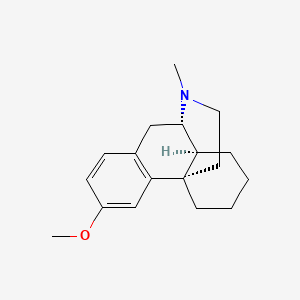Attribution Statement: LactMed is a registered trademark of the U.S. Department of Health and Human Services.
NCBI Bookshelf. A service of the National Library of Medicine, National Institutes of Health.
Drugs and Lactation Database (LactMed®) [Internet]. Bethesda (MD): National Institute of Child Health and Human Development; 2006-.
CASRN: 125-71-3

Drug Levels and Effects
Summary of Use during Lactation
The amounts of dextromethorphan and its active metabolite in breastmilk are very low and are not expected to affect the nursing infant. It is best to avoid the use of products with a high alcohol content while nursing.
Drug Levels
Dextromethorphan is metabolized to its active metabolite of dextrorphan by CYP2D6. Dextrorphan is further metabolized to dextrorphan glucuronide by UGT2B.
Maternal Levels. Twenty nursing mothers who were extensive metabolizers of CYP2D6 donated a blood sample and completely emptied one breast 2 hours after a single oral dose of dextromethorphan 30 mg. All mothers were at least 3 months postpartum and subjects who were poor, intermediate, or ultra-rapid metabolizers were excluded from the study. The average milk concentration of dextromethorphan at the presumed peak of 2 hours after the dose was 2.5 mcg/L (95% CI 1.5 to 3.9 mcg/L). The average milk concentration of the active metabolite dextrorphan at that time was 14 mcg/L (95% CI 10.7 to 17.9 mcg/L). These values translated to average “worst-case” daily infant dosages of 0.33 mcg/kg and 1.8 mcg/kg, and relative infant dosages of 0.07% and 0.41% for dextromethorphan and dextrorphan, respectively. The authors used published values of serum concentrations after a typical 60 mg twice daily dosage regimen to estimate average steady-state relative infant dosages of 0.04% and 0.07% for dextromethorphan and dextrorphan, respectively.[1] The potential contribution of dextrorphan glucuronide to infant dosage in neonates, who can deconjugate glucuronides some compounds, was not estimated.
Eight women who were given dextromethorphan (dose not specified) following a full-term cesarean section delivery provided milk samples at 4 to 6 hours after their third dose. The authors calculated median estimated relative infant doses to be 0.239% for dextromethorphan and 0.288% for its major active metabolite, dextrorphan.[2]
Infant Levels. Blood samples were obtained at an unspecified time from 8 breastfed infants whose mothers were given dextromethorphan (dose not specified) following a full-term cesarean section delivery. Only one of the 8 infants had a detectable plasma concentration of dextromethorphan. This infant’s mother had a much higher milk level of dextromethorphan than the other 7 women.[2]
Effects in Breastfed Infants
Relevant published information was not found as of the revision date.
Effects on Lactation and Breastmilk
Relevant published information was not found as of the revision date.
References
- 1.
- Shum S, Yadav A, Fay E, et al. Infant dextromethorphan and dextrorphan exposure via breast milk from mothers who are CYP2D6 extensive metabolizers. J Clin Pharmacol 2022;62:747-55. [PMC free article: PMC9153952] [PubMed: 34889461]
- 2.
- Lieberman D, O'Brien D, Meyers R, et al. Assessment of dextromethorphan concentration in human breast milk. Am J Obstet Gynecol 2023;228:S119. doi:10.1016/j.ajog.2022.11.242 [CrossRef]
Substance Identification
Substance Name
Dextromethorphan
CAS Registry Number
125-71-3
Disclaimer: Information presented in this database is not meant as a substitute for professional judgment. You should consult your healthcare provider for breastfeeding advice related to your particular situation. The U.S. government does not warrant or assume any liability or responsibility for the accuracy or completeness of the information on this Site.
- User and Medical Advice Disclaimer
- Drugs and Lactation Database (LactMed) - Record Format
- LactMed - Database Creation and Peer Review Process
- Fact Sheet. Drugs and Lactation Database (LactMed)
- Drugs and Lactation Database (LactMed) - Glossary
- LactMed Selected References
- Drugs and Lactation Database (LactMed) - About Dietary Supplements
- Breastfeeding Links
- PMCPubMed Central citations
- PubChem SubstanceRelated PubChem Substances
- PubMedLinks to PubMed
- Review Dexamethasone, Topical.[Drugs and Lactation Database (...]Review Dexamethasone, Topical.. Drugs and Lactation Database (LactMed®). 2006
- Review Methazolamide.[Drugs and Lactation Database (...]Review Methazolamide.. Drugs and Lactation Database (LactMed®). 2006
- Review Tolmetin.[Drugs and Lactation Database (...]Review Tolmetin.. Drugs and Lactation Database (LactMed®). 2006
- Review Phenprocoumon.[Drugs and Lactation Database (...]Review Phenprocoumon.. Drugs and Lactation Database (LactMed®). 2006
- Review Indomethacin.[Drugs and Lactation Database (...]Review Indomethacin.. Drugs and Lactation Database (LactMed®). 2006
- Dextromethorphan - Drugs and Lactation Database (LactMed®)Dextromethorphan - Drugs and Lactation Database (LactMed®)
Your browsing activity is empty.
Activity recording is turned off.
See more...
